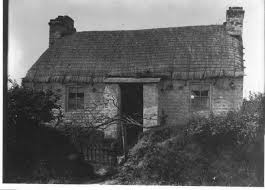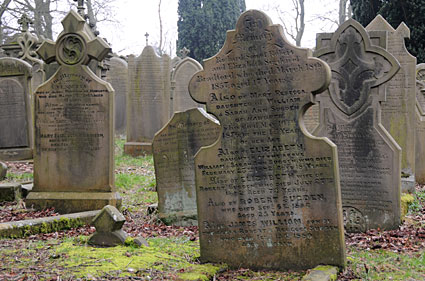Merlin as he appears in the book "Merlin: Shaman, Prophet, Magician" by John Matthews.

We moved to Carmarthenshire 21 years ago this March. I already knew of the town's connection with Merlin - how the town's Welsh name - Caermyrddin - was supposed to be linked to his name; how he was born/raised on Merlin's Hill, which is by Abergwili; how there was a Merlin's stone in a field nearby. We also have - or had - Merlin's Oak (The Priory Oak) which grew at the end of Old Oak Lane, and was encased in concrete to stop it falling and fulfilling the prophecy, "When Merlin's Oak comes tumbling down, so shall fall Carmarthen Town."
I think that books had a lot to answer for in the story of Merlin. Geoffrey of Monmouth (1100ish to 1155 and born in Monmouth), wrote
Historia Regum Britannia in which Arthur was placed in the list of kings. Apart from establishing Arthur, Geoffrey mentioned Merlin, who was known in a literary sense from several Medieval Welsh poems. He first appeared in a book called the Prophecies of Merlin (
Prophetiae Merlini), written about 1135
and then was included in the Historia
. Many people are familiar with the prophecies which Merlin made about the fall of Vortigern and the rise and fall of Arthur
. Geoffrey's Merlin is a romantic combination of Merlin the Prophet of the poems and the
"young and prophetic" Ambrosius of Nennius' story.
Nennius was a Welsh monk writing in the 9th century, and who first mentioned Arthur in his book Historia Brittanum
. Bearing in mind he was drawing largely upon Celtic legend for his History of Britain, and bearing in mind that Geoffrey of Monmouth used it in his own Historia, the factual base of Merlin and Arthur becomes a game of smoke and mirrors . . .

As I learned when studying Archaeology, it is often the case that the same
facts become recycled in a very parochial fashion, without looking outside of the box. This particularly so in the case of Pictish art. It would appear to be no different with Arthur and Merlin. In a severe case of Chinese whispers, a number of individuals would appear to have been
combined. Recent research and books tie Arthur as strongly to Scotland, or to Wales, as he was ever tied to the West Country.
So what do we have factually to tie Merlin here? Legend has it that he was born in a cave (with a spring in) just outside of Carmarthen.
Well, there is a small cave, housing a spring, at the bottom of Merlin's Hill, close to the A40. On the top of Merlin's Hill is an Iron Age hillfort, which gives great longevity to the habitation of the site.
The Black Book of Carmarthen does indeed include poetry which refers to "Myrddin" BUT it must be said that once again, this is the Myrddin/Merlin of legend as it post-dates Geoffrey of Monmouth's book.
Whilst there definitely was a Merlin's Oak, with pieces of it still in the possession of the local Museum and on display in the town hall, the actual tree was planted to celebrate the coronation of Charles II - the town stood for the King in the Civil War. It was killed by poison by a local chap, fed up with the youth of the town congregating beneath it - noisily (some things never change!)
In the 1970s Mary Stewart wrote a quartet of books about Merlin and Arthur - The Cystal Cave, The Hollow Hills, The Last Enchantment and the Wicked Day. They were good reading at the time, but again promulgating the same legends that Geoffrey began.
Below - the stone in Abergwili Churchyard.

There is definitely a Merlin's Stone, in a field near the bottom of Merlin's Hill. Merlin is supposed to have prophesied that one day a Raven would drink a man's blood off it. Merlin is also supposed to have buried treasure nearby and indeed, the stone was responsible for a man's death many many years ago, when some hopeful treasure-hunter was digging at the base of the stone and it fell on top of him! It is on an alignment with a small stone in Abergwili Churchyard, and also, further up the Towy valley, aligned with a largely destroyed Henge Monument in Nantgaredig.
I would think, personally, that it has far more relevance to the prehistory of the Towy Valley than the early Medieval and Merlin. That is as PROOF positive as I can be, though, being a romantic, I would love to think that Merlin, and Arthur and his men still sleep with their swords at the ready, beneath Merlin's Hill, waiting for their call to arms to save us.
Many, many books have been written about Merlin, and Arthurian legend - indeed we have a dozen or more ourselves. By all means read the books, visit Carmarthen and the other places associated with Arthurian legend, and then make up your own mind.

View of the Towy Valley, where Merlin may have roamed as a boy.











 I did try to sort this out in PhotoImpression, but that never related back to the original scan . . . Ah well.
I did try to sort this out in PhotoImpression, but that never related back to the original scan . . . Ah well.










































